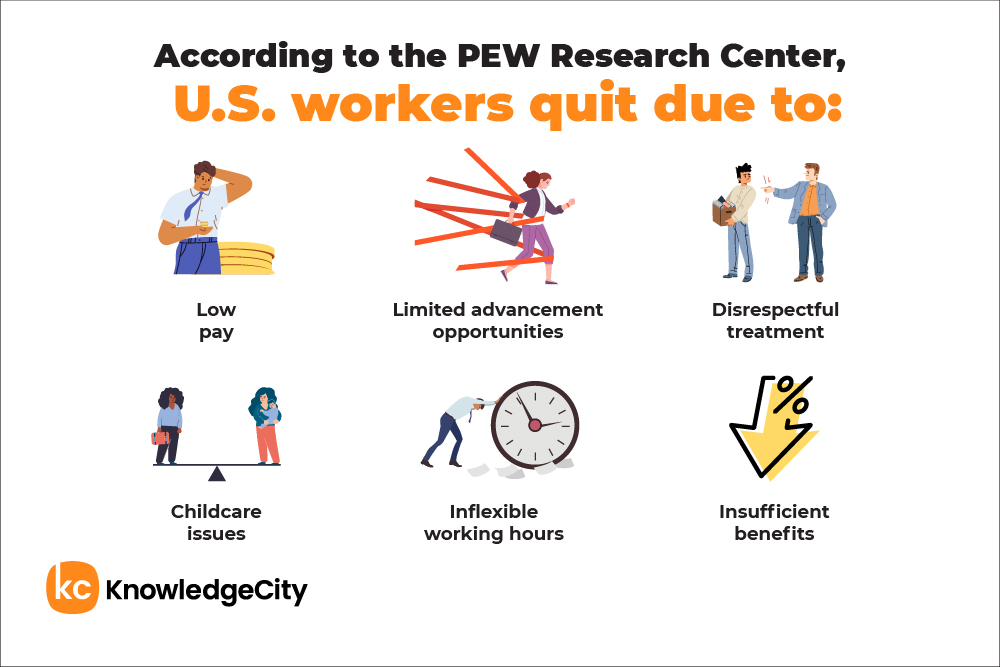Keeping your employees engaged, inspired, and optimistic about their future is key to a successful employee retention strategy. When you consider the high cost of recruiting and training, it makes good business sense to develop a solid staff retention plan for your organization.
The first step to avoiding high turnover is understanding the reasons why people resign from their jobs. According to the Pew Research Center, conditions that have prompted U.S. workers to quit include:
- Low pay
- Limited advancement opportunities
- Disrespectful treatment
- Childcare issues
- Inflexible working hours
- And insufficient benefits

While factors like competitive pay and benefits will continue to impact retention, encouraging employees to stay with your company requires a combination of incentives and perks. The good news is that talent retention doesn’t have to be an expensive proposition.
Here’s an assortment of helpful employee retention strategies that can help fuel your organization’s growth and stability.
Retention Strategies
Help your employees maintain a healthy work-life balance.
Burnout is one of the primary reasons why employees resign. Many factors contribute to burnout, but the main issue is often an imbalance between working hours and family time.
Nearly 40% of survey respondents stated that they quit their jobs because they were working too many hours. This problem can sometimes be worse for remote and hybrid workers since the lines between their professional and private lives can become blurred.
Encouraging your employees to maintain a healthy work-life balance can begin during onboarding and be reinforced during performance reviews. Offering employees perks like mental health services, fitness facility access, and flexible schedules that accommodate family needs are vital strategies for preventing employee burnout.
A healthy work-life balance has become a requirement for many employees in the past couple of years. A study by Microsoft provides a clear snapshot of shifting priorities that have triggered waves of resignations since the pandemic began.
According to the study, “The top five reasons employees quit are personal well-being or mental health (24%), work-life balance (24%), risk of getting COVID-19 (21%), lack of confidence in senior management/leadership (21%), and lack of flexible work hours or location (21%).”
Provide a career path.
While some employees are content with steady work and nominal annual pay raises, most top talent are looking for clearly defined career development opportunities.
By creating an environment in which ambition and hard work are rewarded with promotions and advancement, fewer employees will be tempted to seek these opportunities elsewhere. Training, subsidized conference attendance, and tuition reimbursement are a few key strategies for making employees feel valued.
Online training is another approach to enhancing skills and preparing employees for greater challenges within your organization.
Feed the need for recognition within your organization.
Feeling disrespected by leadership was one of the main reasons employees left their jobs during the pandemic. A lack of appreciation for a job well done leads to feelings of detachment, resentment, and discontent.
A study of more than 12,000 employees conducted by Gallup and Workhuman underscored the mutual benefits achieved through employee recognition.
In a report highlighting the study’s findings, the authors offered the following conclusion: “Leaders who strategically incorporate recognition into their culture can drastically improve employees’ perception that they’re valued, cared for, and respected as people. This makes recognition a low-cost, high-impact way to move the needle on wellbeing.”
Keep employee wages and benefits competitive.
As the cost of living rises and high turnover plagues countless companies, employers are taking a closer look at their compensation packages. Striking a balance between offering competitive salaries and abiding by budgetary restraints is a balancing act many small-to-medium-sized organizations grapple with. From an employee retention standpoint, your company must stay on par with other employers in your industry and job market.
Make sure onboarding sets a positive tone.
The onboarding process not only serves as an orientation for new employees, but also presents an opportunity to make them feel welcome, valued, and challenged positively.
Since first impressions can have a long-lasting effect on an employee’s outlook, it pays to plan the onboarding process and how it’s presented. Emphasizing desirable aspects of the job, such as advancement opportunities, competitive benefits, an inclusive working environment, and an active learning culture can help set positive expectations for new team members.
Provide managers with communication training.
The best plans for retaining quality employees can fail if the managers aren’t on board with the strategy. Many workers resign because they feel disrespected, unheard, or treated unfairly by leadership.
By providing supervisors with classroom or online training courses on topics like active listening, team building, communicating with diplomacy and tact, and building rapport, they’ll be better able to motivate, guide, and relate to their staff.
Offer your employees remote work options.
As a result of the pandemic, workers have become accustomed to working from home, at least on a part-time basis. For many, remote work is a prerequisite for accepting a job offer or remaining with an employer. While it’s not always practical to allow your team members to work exclusively from home, hybrid work options are often seen as a mutually beneficial arrangement.
Help your employees stay healthy.
Make health and fitness programs available to personnel to not only benefit your organization but to show your employees that you care about their overall well-being. When it comes to wellness programs, you can offer periodic cholesterol and blood pressure screenings or bring in experts to share advice on proper nutrition, stress reduction, and quitting smoking. Other wellness options include yoga classes, health club memberships, and mental health services.
Cultivate an inclusive company culture.
Provide employees with training in diversity, equity, and inclusion to create a more respectful work environment and attract a diverse range of talented personnel who are in touch with the needs of multicultural customer bases.
According to an article from Indeed, the advantages of diversity in the workplace range from greater productivity to reduced employee turnover. One of the most significant advantages of diversity in the workplace is that employees often feel more comfortable and satisfied in inclusive environments. They also tend to be more loyal and are more inclined to stay longer at companies where their unique contributions are recognized and respected.
Make communication a two-way process.
Provide employees with feedback about strengths, weaknesses, and opportunities for improvement, and consider asking staff members how you can do a better job of meeting their needs. A major reason employees quit their jobs is because they feel invisible, disregarded, and ignored.
Taking the time to ask for and listen to their suggestions and needs can go a long way toward inspiring loyalty from high-potential workers and managers. It’s a simple yet effective talent retention strategy that’s often overlooked. Other effective talent retention strategies include using employee surveys, suggestion boxes, and exit interviews to gather relevant feedback.
Offer flexible hours and working conditions.
Flexibility must be a two-way street, adopting a “give and take” mentality toward working hours and location to result in greater employee dedication and retention. As a Washington Post article states, “The focus of true work-life flexibility is productivity rather than where and when work gets done.”
Develop strategies to reduce employee turnover.
Employee engagement is the catalyst for motivating, retaining, and bringing out the best in your workers and professional staff. For actionable tips on promoting engagement in your organization, download a free copy of KnowledgeCity’s ebook “Simple Solutions for Boosting Employee Engagement.”
These cost-effective employee retention strategies are results-oriented and can help stop the trend of resignation, quiet quitting, and career cushioning in your organization and industry.
Subscribe to Our Newsletter
Join 80,000+ Fellow HR Professionals. Get expert recruiting and training tips straight
to your inbox, and become a better HR manager.

 KnowledgeCity
KnowledgeCity 










